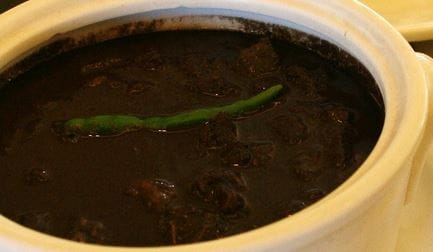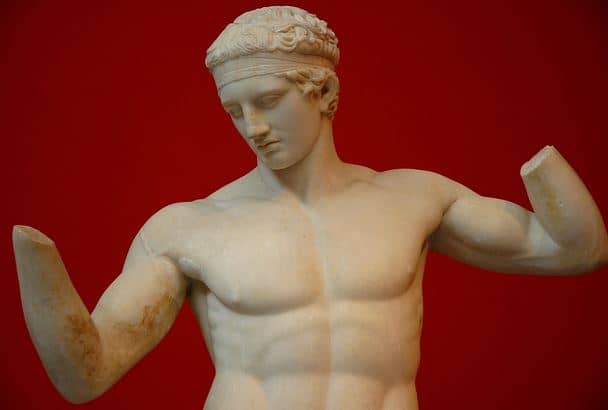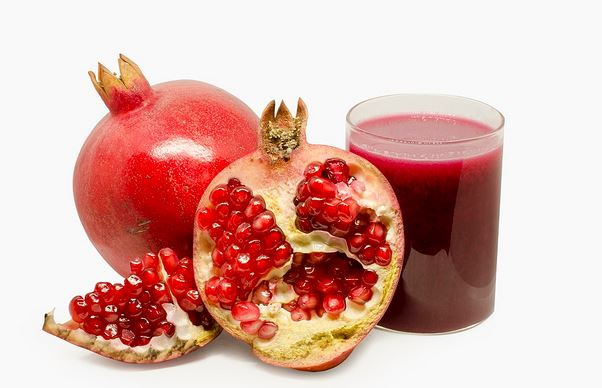What did the ancient Greeks eat?
Before getting into what ancient Greek food was like we have to consider geography, culture and history. Luckily ancient Greeks were known to document their life and history in art and in writing, which makes the information much easier to piece together. In fact, part of the allure of writing about this topic is how this civilization ate and how that relates to the impressive physiques that are seen in Greek works of art. That’s not to say that the diet of a Spartan warrior or Olympic athlete might not have been different than a poor laborer but there certainly would have been similarities.
Also, the diet of the ancient Greeks would surely have varied based on geography due to Greece’s terrain.
Ancient Greek food and terrain consideration
Greece is surrounded by water and also has many islands. On the other hand, the country also has mountains, valleys and hills which may have made travel difficult or slow.
This means that different regions may have had some differences in their diet, especially meats. Greece was also known for trade with ancient works of art being found far from where it was created. As a coastal country they could travel by boat along the coast to sell or purchase different varieties of food.
Agriculture in Ancient Greece
The ancient Greeks were an advanced civilization for their time and agricultural techniques would have been no different. They would have used methods that would have resulted the best yield given the circumstances.
But due to terrain and soil quality issues ancient Greeks had certain crops they could grow on their own, others they would acquire through trade.
Olives and grapes were plentiful because they could grow them on hillsides and in mountainous areas. Fruit crops that were common in ancient Greece were apples, pears, pomegranate and figs. Available vegetables crops were cucumbers, onions, lettuce and garlic. Nuts were also abundant, such as almonds and walnuts. Bread was very popular in Greece at that time as they were able to grow wheat and barley.
Ancient Greek animal food products
Ancient Greeks had access to and made use of various dairy products for milk and cheese production. Goats were popular because they are agile and can navigate and thrive on uneven terrain. They are also well known for eating just about anything. Cattle was available as well but they were probably more common in flatter areas with plenty of room to graze. Most Greeks did not drink milk as it was considered barbaric. Instead, they used it primarily for cheese production or to make yogurt. It was occasionally used as medicine however.
Meat was definitely part of the ancient Greek diet but certain meat products may have dominated certain areas.
For example, coastal areas would have produced a wide variety of seafood like fish, squid, octopus and different types of shellfish. In other large grassy areas would have provided goat, cattle, pigs and poultry. The ancient Greeks also regularly ate the internal organs of animals which have a high nutritional value. Obviously, eggs would have been on the menu, either found wild or raised. One of the more unusual foods I discovered was “black soup” or “black broth”. This soup is made with pig and includes blood from the animal along with salt and vinegar.
Of course, there was always wild game to be had such as rabbit, pheasant, deer and wild boar.
The Greeks did have preservation methods for their food so they could easily have traveled to purchase different varieties or even traded some of their own food types in exchange for others. Methods of preserving food that ancient Greeks used included salting, drying, smoking and preserving them in syrup or fat.
Ancient Greek food of the average citizen
The average citizen with some land to tend would have primarily dined on bread products, legumes, vegetables and fruit. Animals that don’t require much space to raise, such as chicken, would have provided meat or eggs.
A typical breakfast was generally pretty light and consisted of bread or a type of porridge. In a practical sense this makes a lot of sense considering most Greeks of the time spent time performing manual labor, much of the time outdoors. A light breakfast provides energy but does not hamper performance with a full belly or diverting energy to digesting a large meal.
Lunch was similarly light. Usually it consisted of more bread, possibly dipped in wine, cheese, figs and/or olives.
Dinner was the big meal of the day. While the average Greek may not have had much in the way of red meat products on a regular basis, they still were able to consume protein. Dinner was often a social event but men and women ate separately. Depending on location a typical dinner would have been vegetables such as artichokes or salad with drizzled olive oil, proteins like eggs or perhaps fish, fruit like pomegranate, apples or figs and bread. Legumes were important as well; the ancient Greeks would have had various types available such as black beans or lentils. Lentils contain 18 grams of protein per cup for those that were wondering. For sweets ancient Greeks would use honey and dip either bread or other food like olives in it.
These foods could be prepared any number of ways. For example, they were eaten separately or they could be made into soups and with grains. The ancient Greeks would also make different varieties of cakes with nuts, fruit and honey.
Ancient Greek food of the Spartans
In ancient Greece certain areas provided daily community meals or banquets for men both young and old. These “Syssitions” where most evolved in Sparta and attendance was required. In fact, even kings were expected to attend and any absence required a good excuse.
These banquets served to form strong bonds and kinship amongst different social groups as each group typically had their own Syssitia based on religious or social affiliations. Indeed, having soldiers eat and socialize together during times of peace would have served to form loyalty among and bring a greater sense of shame to soldiers not fulfilling their duty in front of the community they dined with every night.
Every meal began with wine that was mixed with water and the soldiers were allowed refills as they saw fit, but drunkenness was not acceptable. The main meal consisted of the infamous “black broth” or “black soup“, which was boiled pig leg, pig blood, salt and vinegar. Soldiers would dip whole grain pieces of bread into the soup as well. After the main meal the Spartans would be presented with after meal treats that included fruit, wild game, poultry, cheese and other foods.

Spartan training and nutrition
While the thought of consuming a soup made of pig’s blood every night might be unappealing, it served a purpose. The broth alone was packed with more protein than any protein powder we have on the market today. 100 grams of this broth translates into just under 4 fluid ounces. The nutritional value of pig’s blood is as follows per 100 grams: 78 calories, .2 grams of fat, .4 grams of carbohydrates and 18.4 grams of protein. Additionally, pig’s blood is reportedly easy to digest and is filled with iron, B complex vitamins, calcium and phosphorous. As mentioned, Spartans ate more than just black broth but it was clearly a staple.
As children, Spartan boys were turned over to the state at the age of 7 where they would be trained to become fit and strong and developed into soldiers. Daily activity would involve javelin and discus throwing, wrestling, boxing, swimming and running. While they were not taught military tactics yet their minds and bodies were being forged until they became adults. As adults these men were then learning to fight on the battlefield. This meant learning tactical maneuvers and carrying shields that weighed up to 30 pounds. These soldiers needed to possess the strength and endurance to move the shields effectively during military training. They also needed to be able to navigate the terrain which included hills and mountains.
Ancient Greek training and nutrition for athletes
Ancient Spartan males may have been born and bred to be soldiers but that did not mean other Greeks were sedentary.
Gymnasiums could be found all over Greece and were used as places to train the body and mind. The Greeks did not just value health and aesthetics they understood that physical fitness was important for military readiness. As such, physical training was available to every boy and man in the gymnasium, whether or not they were Olympic athletes.
Victorious athletes in these competitions would win significant prize money and other perks since they brought glory to their city. As such the gymnasium was often staffed with former champions as trainers and they made use of early versions of strongman equipment in their training. For example, an early version of dumbbells was known as haltere.
The athletes also had nutritional guidance from physicians, trainers and sometimes the athletes themselves.

How did ancient Greek athletes eat?
Much like Spartan soldiers the athletes of ancient Greece trained intensely and often. Therefore, it was important that they not only ate enough volume to give them energy but they had to eat foods that would build strength and size.
Unlike soldiers, champion athletes trained specifically for their sport. In early Olympics there were no weight divisions and therefore an athlete with superior size and strength would have an advantage. This is especially true in boxing, wrestling and pankration. This may also be true for sports like the discus and javelin throw where strength, size and speed are a factor. Events such as running would require different body types and therefore different nutrition.
Generally speaking, an athlete in ancient Greece would eat similarly to an ordinary citizen. The major difference would be an increased and focused protein intake. Milo of Croton, a six-time Olympic champion, was said to have consumed 20lbs of meat and 20lbs of bread each day. While clearly and exaggeration, this shows that his meals was heavy in protein.
Prior to the time of Milo, athletes would rely on figs, fruit, bread and cheese as nutritional sources. It was Pythagoras, who was also a was a gymnastics teacher that advised athletes to add meat to their diet. Trainers eventually developed guidelines for athletes which included limiting wine, skipping dessert and avoiding cold water. Other Greeks that documented the high meat diet were Galen (a physician) and Pausanias (geographer and writer).
Variety in Ancient Greek Foods
It is too simple just to say “these people ate this” or “those people ate that”. But thanks to Greece’s geography and their documentation we are able to piece together how people ate.
We do know that the foundation of their diet centered around the “Mediterranean Triad”. These were olives, grapes and grains, which were the most available crops of the time. The rest of the diet would have relied on wealth, region, preference and occupation to fill in the gaps.
It is clear that the ancient Greeks were an active people that valued food as much for function as pleasure as evidenced by their approach to diet and physical achievement.
Common Ancient Greek food
This is by no means a complete list but it gives an idea of what was available at that time.
Grains
- Wheat
- Barely
- Millet
- Emmer
Legumes
- Fava beans
- Black beans
- Chick peas
- Bitter vecht
- Grass peas
- Lentils
- Lupin beans
- Green peas
Vegetables
- Lettuce
- Cucumbers
- Onions
- Artichoke
- Asparagus
- Olives
- Turnips
- Radishes
- Carrots
- Celery
- Cabbage
Fruit
- Pomegranate
- Figs
- Apples
- Grapes
- Raisins
- Pears
Nuts
- Almonds
- Chestnuts
- Beechnuts
- Walnuts
Meat
- Birds of all type (doves, crane various waterfowl)
- Domesticated birds (chicken, geese, pheasant)
- Pigs
- Goat
- Sheep
- Cows
- Wild game (boar, deer, rabbit)
Fish
- Tuna
- Swordfish
- Grouper
- Snapper
- Parrot-fish
- Carp
- Rays
- Mullet
- Mackerel
- Sardines
- Anchovies
- Sturgeon (freshwater or saltwater)
- Eel (freshwater)
- Catfish (freshwater)
- Pike-fish (freshwater)
- Squid
- Octopus
- Shellfish
Eggs and Dairy
- Milk (cow and goat)
- Cheese
- Yogurt
- Eggs (all types)



